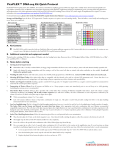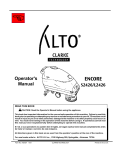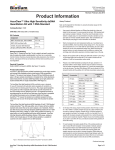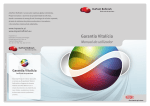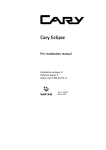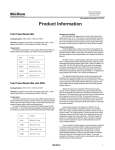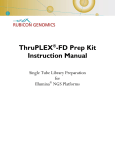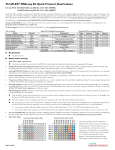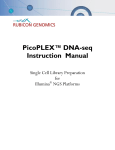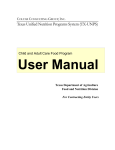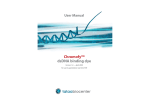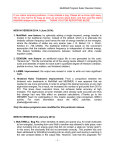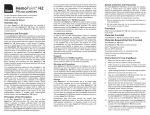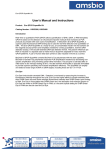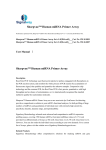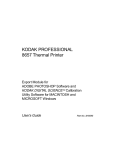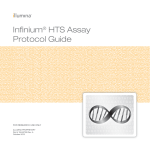Download PI-30071 - Biotium
Transcript
3159 Corporate Place Hayward, CA 94545 www.biotium.com Glowing Products for ScienceTM Revised: February 6, 2014 Product Information AccuOrange™ Protein Quantitation Kit Assay Protocol Catalog Number: 30071-T (200 assays), 30071 (2000 assays) Note: see the Appendix for information on using the AccuOrange Protein Quantitation Kit with the AccuLite™ 470 Mini Fluorometer. Kit Contents Component 30071-T 200 assays 30071 2000 assays AccuOrange buffer, 10X (contains 2 mM sodium azide) 5 mL 30071A-T 50 mL 30071A AccuOrange dye, 500X in DMSO 100 uL 30071B-T 1 mL 30071B Bovine serum albumin (BSA) standard, 2 mg/mL (contains 2 mM sodium azide) 100 uL 99990-T 1 mL 99990 1. Prepare 1X AccuOrange buffer by diluting 10X buffer (component 30071A) 1:10 in dH2O. For example, add 1 mL of 10X assay buffer to 9 mL dH2O. 1X assay buffer can be stored at room temperature. 2. Immediately before use, prepare AccuOrange working solution by diluting 500X AccuOrange dye (component 30071B) 1:500 in 1X AccuOrange buffer. For example, add 10 uL of 500X AccuOrange dye to 5 mL of 1X assay buffer. Note: You will need about 3 mL working solution for each standard curve (see Table 1) and 250 uL working solution for each sample. 3. Number of assays based on 96-well format. Storage and Handling Store at room temperature. Do not refrigerate AccuOrange buffer. Protect AccuOrange dye from light. Product is stable for at least 1 year from date of receipt when stored as recommended. If precipitate forms in Assay Buffer, heat to 37oC and swirl to re-dissolve. No data are available on the safety of AccuOrange dye. Handle using universal laboratory safety precautions and dispose of the dye as chemical waste. Note: You may wish to perform a few different dilutions of your unknown sample. See Table 2 for the assay tolerance levels for buffer components and potential contaminants. Sample dilution may reduce the concentration of interfering substances to tolerable levels. 4. Spectral Properties Ex/Em 480/598 nm with BSA in 1X assay buffer (Fig. 1) Emission Absorption AccuOrange is recommended for quantitating purified protein or antibody samples. The tolerance of the AccuOrange assay to salts, buffers, detergents, and other chemicals is shown in Table 1. The AccuOrange assay has low tolerance for non-ionic detergents, and is not recommended for use with cell lysates containing Triton X-100, sodium deoxycholate, CHAPs, or other non-ionic detergents. The assay can tolerate up to 0.01% SDS (final concentration in assay). 450 550 Wavelength (nm) 650 Prepare a protein standard curve by performing serial dilutions of the BSA standard in AccuOrange working solution as shown in Table 1. Note: the standards will be measured at the concentrations shown in Table 1, without further dilution. Product Description AccuOrange™ Protein Quantitation Kit is a highly sensitive fluorescence-based assay for quantitating purified protein samples in 96-well format. The detection range of the assay is 0.1-15 ug/mL protein. AccuOrange is much more sensitive than traditional protein quantitation assays such as BCA, Bradford and Lowry, and shows superior linearity and reproducibility compared to the NanoOrange® protein quantitation assay (Figure 2). The assay shows minimal variability between different proteins. After protein samples are heated wtih the dye, the fluorescence signal is stable for up to 16 hours at room temperature. 350 Prepare unknown samples by adding up to 10 uL of sample to 250 uL AccuOrange working solution. 5. Heat samples and standards to 90oC-95oC for 10 minutes, protected from light. Samples can be heated in microcentrifuge tubes in a water bath or heat block. Screw cap tubes or cap locks are recommended to prevent caps from popping open during heating. Note: Alternatively, samples can be heated in a multiwell plate with a heat-resistant seal using a thermocycler with a heated lid. Scale all volumes in the assay proportionally to fit the well volume of the plate. Centrifuge the plate to collect any condensation that forms on plate seal after step 6. 6. Remove samples from heat and allow to cool to room temperature for 20 minutes, protected from light. Centrifuge tubes briefly to collect any condensation from caps and vortex to mix. 7. Transfer 200 uL of each standard or sample to 96-well microplate wells to read on a fluorescence microplate reader. Measure fluorescence with excitation/emission at 480/598 nm. Note: Alternatively, samples can be transferred to a fluorescence cuvette and measured using a spectrofluorometer. If more than 200 uL is required for measurement, scale all volumes in the assay proportionally. 750 Figure 1. Absorbance and emission spectra of AccuOrange dye with BSA in 1X AccuOrange assay buffer. AccuOrange™ Protein Assay Kit Page 1 of 3 PSF006 Volume of working solution Final BSA concentration (ug/mL) 2500 A 7.5 uL BSA std (2 mg/mL) 1 mL 15 2000 B 333 uL solution A 167 uL 10 C 250 uL solution B 250 uL 5 D 250 uL solution C 250 uL 2.5 E 200 uL solution D 300 uL 1 F 250 uL solution E 250 uL 0.5 G 250 uL solution F 250 uL 0.25 H 100 uL solution G 150 uL 0.1 I 0 mL 250 uL 0 Table 2. Assay tolerance levels for interfering substances Compound Maximum tolerable concentration (final concentration in assay) SDS 0.01% Triton X-100 Below 0.001% Tween 20 Below 0.001% CHAPS Below 0.001% Sodium deoxycholate (DOC) Below 0.001% Urea 10 mM DTT 100 mM bME 0.1% EDTA 1 mM Sucrose 10 mM (0.34%) Glycerol 1% PBS 0.02X NaCl 1 mM CaCl2 0.01 mM MgCl2 0.2 mM ZnCl2 0.2 mM Ammonium sulfate 1 mM Sodium azide 2 mM Imidazole 50 mM Tris 1 mM Glycine 100 mM Amino acids 10 ug/mL DNA 10 ug/mL Fluorescence Volume of BSA solution Fluorescence Table 1. Preparation of BSA standards. 1500 400 200 0 NanoOrange R² = 0.9453 0 0.5 1 BSA (ug/mL) 1.5 1000 AccuOrange R² = 0.9981 500 AccuOrange NanoOrange 0 0 5 10 15 BSA (ug/mL) Figure 2. BSA titration assayed using AccuOrange Protein Quantitation Kit or NanoOrange Protein Quantitation Kit from Life Technologies according to manufacturer’s protocol and read on a microplate reader at the recommended wavelengths for each assay. Inset shows the lower end of the curve. Error bars represent standard deviation of the mean for triplicate samples. Related Products Please visit our website at www.biotium.com for information on our life science research products, including Lumitein™ protein gel stain, environmentally friendly EvaGreen® qPCR master mixes, fluorescent CF™dye antibody conjugates and reactive dyes, apoptosis reagents, fluorescent probes, and kits for cell biology research. NanoOrange is a registered trademark of Molecular Probes Inc. Materials from Biotium are sold for research use only, and are not intended for food, drug, household, or cosmetic use. AccuOrange™ Protein Assay Kit Page 2 of 3 PSF006 Appendix: AccuOrange High Sensitivity Assay Protocol for the AccuLite 470 Fluorometer Main Menu Measure Calibrate Info Data Sample Preparation 1. Prepare samples and standards as described in steps 1-6 of the product protocol. Only the 0 ug/mL BSA standard (standard I in Table 1) and 10 ug/ mL BSA standard (standard B in Table 1) are required. 2. Transfer 200 uL of each sample into a 0.2 mL thin-walled clear PCR tube. If using glass mini tubes (cat. no. 22019), 100 uL sample can be used for measurement. Calibration To move to a previous screen at any time, select Return. Continue selecting Return to go back to the Main Menu. 1. From the AccuLite Main Menu, select Calibrate. 2. Select AccuOrange from the assay list. 3. Insert the blank tube (0 ug/mL BSA) and close the cover. Select Blank. 4. The standard value 00010.000 will display. Insert the 10 ug/mL BSA standard tube and close the cover. Press Measure. 5. Calibration Finished will appear on the screen. 6. Select Return to return back to the Main Menu. Sample Measurement 1. From the AccuLite Main Menu, select Measure. 2. Select AccuOrange from the assay list. 3. Insert the first sample tube and close the cover. Select Measure. The value shown is in ug/mL protein. 4. Select Save to save the data in the meter. Alternatively, you can manually the record data without saving, then select Return. 5. Insert next sample and select Measure. 6. After reading all samples, select Return repeatedly to navigate back to main menu. Retrieving Saved Data 1. From the AccuLite Main Menu, select Data. 2. Select AccuOrange from the assay list. 3. Use the arrow keys to navigate through saved data points. Data points are numbered (##) in order of measurement. 4. To erase data, select Erase All and Confirm. 5. To return to previous screens, select Return. 1. Select Calibrate 7. Select Measure 13. Select Data Accu dsDNA AccuOrange Assay 3 Return Accu dsDNA AccuOrange Assay 3 Return Accu dsDNA AccuOrange Assay 3 Return 2. Select AccuOrange 8. Select AccuOrange 14. Select AccuOrange AccuOrange Blank Return AccuOrange Blank Measure Return [Data] <- ## -> Erase All Return 3. Insert blank tube, select Blank 9. Insert sample tube, select Measure 15. Use arrows to scroll through data points. -orSelect Erase All 00010.000 <- Std -> Measure Return [Timer] [Data Value] Save Return Confirm? 4. The 10 ug/mL standard is displayed (00010.000) 10. Select Save (or Return if not saving) Return 5. Insert 10 ug/mL standard tube, select Measure Calibration Finished Return 6. Select Return once to return to Main Menu [Timer] [Data Value] Measure Return (Erase All) 16. Select Return repeatedly to return to Main Menu. 11. Insert next sample tube, select Measure. Repeat for each sample. 12. Select Return repeatedly to return to Main Menu. Figure 4. AccuLite user menu tree showing AccuOrange calibration, measurement, and data retrieval steps. See the AccuLite user manual for complete user menu tree. Performing a Full Calibration Curve with AccuLite The first time you perform the assay, or if unexpected results are obtained, you may wish to perform a full calibration curve to verify that the assay is performing properly. In this case, perform the 2 point calibration as described above, then read the full set of standards as if they were unknown samples. Plot the standard curve as described in the product protocol. AccuOrange™ Protein Assay Kit Page 3 of 3 PSF006



